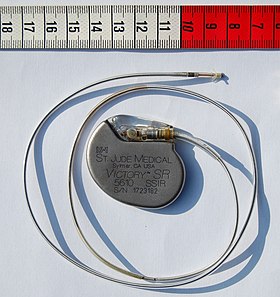| Artificial cardiac pacemaker | |
|---|---|
 | |
| Specialty | Cardiology, electrophysiology |
An artificial cardiac pacemaker, commonly referred to as simply a pacemaker, is an implanted medical device that generates electrical pulses delivered by electrodes to one or more of the chambers of the heart. Each pulse causes the targeted chamber(s) to contract and pump blood,[3] thus regulating the function of the electrical conduction system of the heart.
The primary purpose of a pacemaker is to maintain an even heart rate, either because the heart's natural cardiac pacemaker provides an inadequate or irregular heartbeat, or because there is a block in the heart's electrical conduction system. Modern pacemakers are externally programmable and allow a cardiologist to select the optimal pacing modes for individual patients. Most pacemakers are on demand, in which the stimulation of the heart is based on the dynamic demand of the circulatory system. Others send out a fixed rate of impulses.[4]
A specific type of pacemaker, called an implantable cardioverter-defibrillator, combines pacemaker and defibrillator functions in a single implantable device.[5] Others, called biventricular pacemakers, have multiple electrodes stimulating different positions within the ventricles (the lower heart chambers) to improve their synchronization.[6]
- ^ "Devices@FDA". www.accessdata.fda.gov. Retrieved 2022-04-27.
- ^ Product Performance Report – Cardiac Rhythm Management (PDF) (Report). St. Jude Medical. October 2008. Archived from the original (PDF) on 2022-08-19. Retrieved 2022-04-27.
- ^ "UpToDate". www.uptodate.com. Retrieved 2022-08-02.
- ^ "Pacemakers". Retrieved 28 July 2022.
- ^ "Overview of Pacemakers and Implantable Cardioverter Defibrillators (ICDs) – Health Encyclopedia – University of Rochester Medical Center". www.urmc.rochester.edu. Retrieved 2022-08-02.
- ^ "Biventricular Pacemaker". Cleveland Clinic. Retrieved 2022-08-02.